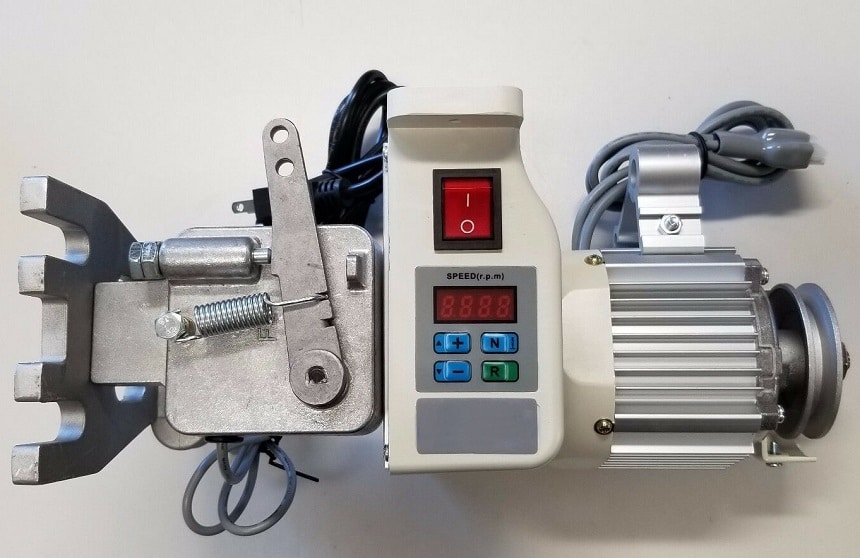

What difference would a servo motor for sewing machines make to you? How do better speed control, quiet operation, and increased energy savings sound? The best servo motors deliver all three and more, but how easy is it to find one? Very easy when you choose from our top-rated motors.
These motors stand out for their high-speed variations, which you can adjust with the flick of a button. They yield enough power output to sustain speeds as high as 3300-4500 RPM and equally high torque. And, although they pack a heavy power punch, the best servo motors are light, with most of them weighing approximately 10 pounds, which makes them easy to transport. As a sign of good faith and the builder’s confidence in the products, they also come with a warranty, which lets you know that the manufacturer stands behind their product, so it must be of reasonable quality. Read our servo motor guide and take your pick!
And once you’re done, you might like to check out the 6 best eversewn sewing machines on the market!
More features: speed control knob, 110 V, installation kit included
The Enduro SM-550 is a 110V, 3/4 hp, 550-watt industrial sewing machine motor that operates precisely and efficiently. The motor runs at a maximum speed of 3300 rpm, but it’s designed to run at slow speeds just as well, which makes it suitable for a broad range of industrial sewing machine applications, both low and high speed.
Located on the side is a speed control knob that you use to set the speed of your sewing machine. You can switch from 3300 rpm to a speed where you’re only making 1-2 stitches a second without breaking a sweat, and in both extremes, the motor operates smoothly, as you can tell by how neat and even the stitches are. You can also run the motor in reverse by flicking the reverse switch.
Replacing your old motor with this electric servo motor will significantly reduce your power bill because it consumes up to 70% less power than clutch motors of a similar power rating.
This motor is easy to install and comes with a complete installation kit that includes an on/off switch, mounting bolts, vibration dumpers, a belt cover, and all the necessary attaching hardware. Also included is a set of extra carbon brushes. Heavy users will especially be grateful to have the extra brushes to replace the original ones when they wear out. It’s compatible with standard servo mounting holes, so you’ll use your existing bolt holes when installing it.
More features: needle positioner included, adjustable belt tightener, low speed start
The Consew CSM1000 draws 550 watts of power, has 3/4 horsepower, and rotates at a maximum speed of 4200 rpm. It has a starting speed of 200 rpm, but you can use a speed reducer if you’re a beginner or if you would like to run it at an even lower speed for projects that entail using heavy materials such as leather. One thing you’ll be happy about is how quietly it runs.
This Consew servo motor is compatible with any sewing machine that has a belt drive, which means you can use it with your existing belt. You can even mount it on your table and switch between different sewing machines. You only need to adjust the built-in belt tightener for each sewing machine to get a good fit. Adjust the speed using the push button. It’s designed for both home and industrial sewing machines so you’ll get good results with all types of fabric and sewing speeds.
This lightweight motor is easy to use and is not prone to errors. To ease things for you, it comes with a needle positioner so that you don’t spend precious minutes putting the needle in position. Installation is straightforward, and even though the installation instructions are vague, you should figure out how to mount it without any trouble. Instructions on how to adjust the controller are more detailed and clearer, so you won’t be fiddling around in the dark on that one.
It comes with a 1-year limited warranty and a 90-day guarantee on labor.
More features: dial speed control, 110 V
The Yamata FESM 550C is a 110V unit with 3/4 horsepower and a power draw of 550 watts. This is a high torque servo motor for sewing machine, and it produces sufficient power to sew through layers of material. If you regularly use heavy materials or tackle complex projects, this will make working on these kinds of projects easy.
It has a maximum speed of 3300 rpm, and you can adjust the speed accordingly using the built-in speed control button, from sewing one stitch at a time to thousands. The starting speed may still be high for some projects. In this case, slightly pressing down on the foot pedal eases the speed, and through this you can sew approximately 5 stitches per second, which is what you want when working on small projects or using thick materials. The problem with this is that you may not sustain your balance on the pedal for long, especially if you’re new to sewing, and you must apply a controlled amount of pressure to get the desired speed. Users with more experience will probably have an easier time controlling the speed in this way. An alternative solution would be installing a speed reducer, which gives you a more reliable way of reducing the speed to a much slower pace.
This motor’s noise level is low, comparable to a Juki servo motor, so you won’t disturb others who may be in the house even if they are in the room next to yours.
More features: speed adjusting knob, 110 V, treadle rod included
The Rex Industrial Sewing Machine Servo Motor is a 3/4 hp unit with a draw of 550 watts. It has a maximum speed of 3450 rpm and goes from 0 to max with a flick of the speed control button. It runs smoothly at all speeds, but its slowest speed, 600 rpm, is not slow enough for some projects. You can slow the motor further by pressing on the foot pedal a little, but an easier way would be fitting in a smaller pulley. An additional control button allows you to change the direction of the motor (to reverse) if you need to.
There are no user instructions, but installation is easy and swift. Unless your sewing machine is very old, it should fit the bolt holes of your clutch motor well. It may not fit into the mounting holes in some of the older machines, so if you have one of those, you may need to drill new holes. This isn’t hard to do, however, and it comes with all the mounting hardware. The motor has enough height adjustments to give you the right tension for your existing belt, but you can replace the belt if what you have is too short.
The motor is noiseless in standby mode, and only produces noise when you work the foot pedal. Still, the noise it emits is not so loud that it becomes a nuisance to people in your vicinity.
More features: speed control knob, 110 V, installation kit included
The Ceelpeopar 3/4 HP (550 W) Brushless Servo Motor is a must-have piece of kit for anybody who takes sewing seriously. A solid frame holds an aluminium heat shield and a brushless motor that gives variable speeds of anything from 200 to 6000RPM, meaning it can handle almost any level of work you throw at it
And it does all this with an up to 70% improvement on energy efficiency- meaning more bang for your buck, as well as less time spent on the job at hand and more money saved on electricity!
This full kit gives total compatibility with all types of sewing machine- flatbed, overlock, twin-needle, and most industrial sewing machines. You get the brushless servo motor, a digital speed controller,a foot pedal and all necessary mounting hardware-it’s pretty quick to install!
The motor is ‘barely there’ level of quiet, guiding you with intuitive and simple digital controls. Smart protections guard against overloads- electrically sound and meets all safety standards!
With a 2 year warranty as well as a 7 day moneyback guarantee, any serious sewing enthusiast should consider this motor for an upgrade!
Your best chance of walking away with the best servo motor is in understanding how the different components of a servo motor work. You also need to know the critical features the motor must have for it to work effectively and efficiently. This is what this next segment, our buying guide, is all about; we discuss servo motors in detail and tell you what to look for when buying one.
Although they are small, servo motors have a high-power output. They have a high efficiency rate, easily surpassing 90% for most light loads.
Servo motors have better performance and operate more smoothly. The motors can operate at extremely high speeds and still give the desired results. This is because the torque remains constant even when the speed may increase significantly.
Servo motors are highly accurate. They rely on feedback encoders that detect when there is a positioning error and correct it. Therefore, the chances of ending up with a damaged product are minimal.
Additionally, the motor has an error limit designed to protect both the machine and your product. If the errors hit the limit when working on a project, the controller stops the motor to ensure that neither the sewing machine nor the product you’re working on is damaged.
You can adjust the fault limit of your servo motor to a higher or lower level, which gives you better control for each project.
Servo motors also have a high number of controls and adjustable parameters – such as speed, torque, and direction – which allow you to adjust the settings as required for different projects.
Most of them are noiseless when on standby mode, and do not produce too much noise when the motor is running.
They are energy efficient because they only draw power when you engage the foot pedal. As long as you’re not using the foot pedal, the motor does not consume power even if the switch is turned on.
Begin by removing your old motor. Then turn the table upside down for easy access to the surface where you’re going to do the installation. If you can access the underside of the table with ease, you don’t have to turn the table.
Put the screws into the mounting holes, one at a time. Then place the cushions on top of the screws in such a way that the flat part of the cushion touches the table.
Mount the motor, ensuring that the pulley and the belt slot align.
Put the first washer on each bolt, add the second pressure washer, and lastly the nut. Tighten, taking care not to overdo it.
Install the power switch on the table. Make sure you leave some space between the switch and the edge of the table on either side so that an accidental push on either side will not turn the switch on or off. Clip the switch cable on to the table using staples so that it does not get in the way or fall into the belt slot. The staples are usually included in the package when you buy the motor.
Finally, install the belt cover.
For a guided demo on how to install your servo motor, watch this video:
Here now are the features you need to consider when making your purchase.
Servo motors produce enough power output to meet the speed and torque requirements of different applications. Servo motors for industrial sewing machines have 0.7 horsepower and an average power draw of 550W, which guarantees that there is sufficient voltage to run the machine at the desired speed and sustain the torque as needed. They are also rated 110V to match US electrical standards, so you do not need to use any adapters or transformers when connecting the machine to your power supply.
Servo motors are usually small and don’t take up a lot of space. Even if your table is not very big, you’ll be able to install the motor with ease. They are also lightweight, with a good number of them averaging 11-15 pounds. Some are lighter than this, a good example being Yamata FESM 550C, which weighs a mere 5 lbs. Such a motor is easy to move, and you can take it with you to sewing class and even carry it along if traveling and you wish to keep your sewing projects going. This lighter weight also makes servo motor installation an easy, one-person job.
Among the biggest advantages of servo motors is their adjustability and control options, and one area where this applies is speed. These motors can go from zero to maximum speed in a second. You only need to turn the speed button to maximum for this to happen. Maximum servo motor speed ranges from 3000 rpm to as high as 5000 rpm or more. The speed button allows you to increase or decrease the speed to what the project demands. Some materials need to be stitched at a slow speed, while, with others, you can stitch at a much higher speed. When handling large projects, a higher sewing speed means you can finish the project much quicker, and this saves you time.

Servo motors come with a safety feature that shuts off the motor when the system runs into a major error. This protects the sewing machine and the fabric you’re working on. You should also check whether the motor has a shut-off feature that detects high voltage and automatically activates to protect the motor, and by extension sewing machine, from damage.
The average warranty for a sewing machine servo motor is 1 year. Some may have a separate guarantee for labor, an example being Consew CSM1000, which comes with a 1-year limited warranty, with the guarantee for labor lasting 90 days. This can seem short, even inadequate, if you look at it from the viewpoint of someone who hopes to use the motor for years. The good thing is that these types of motors are designed to last, and yours should indeed last a good number of years regardless of the warranty period.
For the most part, installing a sewing machine motor is a straightforward affair that you can accomplish even if you’ve never installed one before. Many motors come with installation instructions and diagrams showing you where each part goes. However, some motors don’t have an installation guide, and so you have to trust your judgment when setting up the motor. If in doubt, get the help of a technician who has experience working with servo motors just so you can have everything set up right. All the hardware you need to mount the motor is included in the box when you buy the product. Therefore, you won’t need to buy anything separately.
Noise
Servo motors produce some noise when the motor is running, but this is nowhere near the noise from clutch motors, which can be as high as 68-70 dB. And when on standby, they do not emit any noise. For this reason, they are the preferred choice for anyone looking to keep noise at a minimum when sewing and are an especially good choice if you’ll be working in close proximity to other people or at odd hours when any form of noise would be an inconvenience to others.
Servo motors are solidly built using quality materials and components and carefully assembled to give them a long lifespan. They are also equipped with mechanisms to protect them from electric faults, such as power surges, which can damage them. On average, servo motors have a life expectancy of 20 years, with the bearings estimated to last, at minimum, 20,000-30,000 working hours. There are variables that may affect the lifespan of your motor, for example, using it at high speed and torque most of the time. You can take steps to increase the longevity of your servo motor, including installing it properly and keeping it away from extreme heat, moisture, and contaminants like oil and dust.
Our top choice is Enduro SM-550, which we like for its smooth speed control and low starting speed. It is versatile since you can use it for a wide range of industrial applications. We also like the reverse feature, how easy it is to install, and the extra carbon brushes it comes with.
Our second choice for the best sewing machine servo motor is Consew CSM1000, whose best features include an extremely low starting speed, high RPM, compatibility with new and old sewing machines, a needle positioner, and an adjustable belt tensioner. We like how quietly it runs and its efficiency at both high and low speeds.